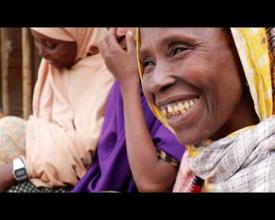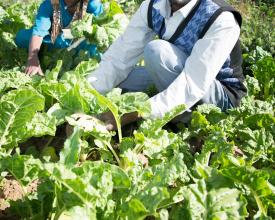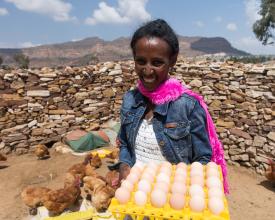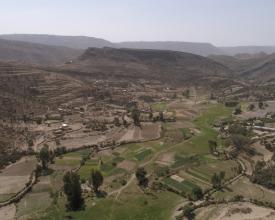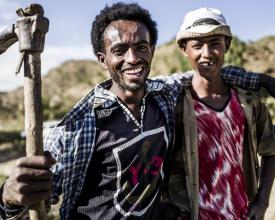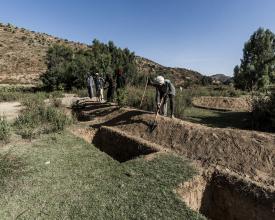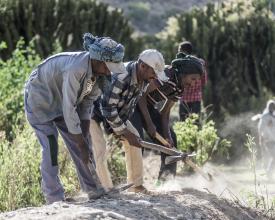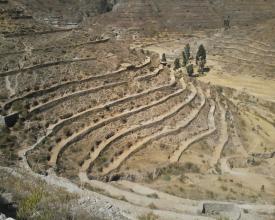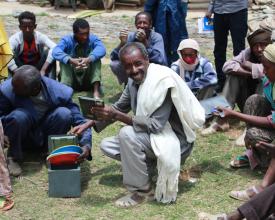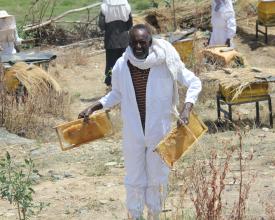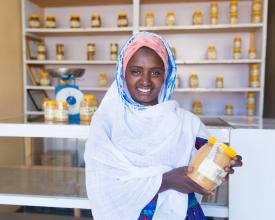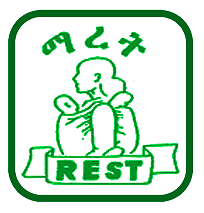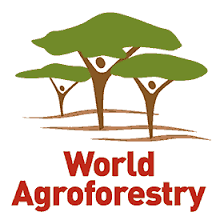
Drylands Development Programme (DryDev): Building resilient communities in dryland areas of Ethiopia through integrated landscape restoration
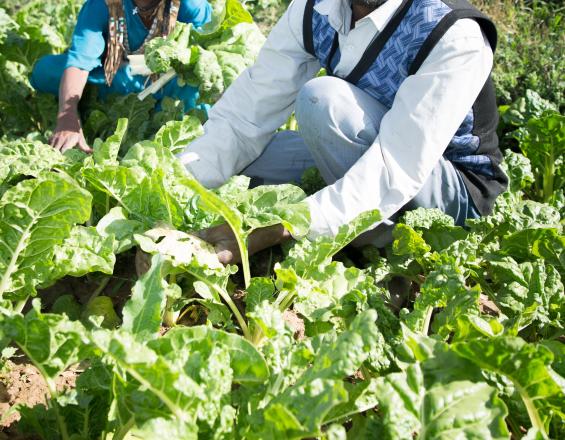
DryDev seeks to address the growing threat of dryland degradation due to climate change and unsustainable natural resource use.
DryDev's approach relies on three pillars:
- Actions that conserve and protect natural assets, such as through water-harvesting, gully reclamation, enrichment planting, and scale-up of farmer managed natural regeneration (FMNR) to restore vegetation and address behaviour change.
- Actions that boost on-farm productivity through relevant training to enhance capacities, such as climate-smart agriculture and small-scale irrigation, and to mobilize community groups and organizations, building skills in governance and problem-solving.
- Actions that link smallholders with profitable value chains, markets, and financial services to improve income.
Gender inclusion through women's participation and empowerment is crucial to facilitating DryDev's landscape restoration and transformational change.
Contexto
Défis à relever
Major challenges that this solution addresses include:
- Environmental: The DryDev approach built environmental resilience through water buffering. Water-harvesting, enrichment planting and FMNR caused rainwater to infiltrate rather than flood. Springs recovered and watertables rose, supporting resilience in the face of recurring droughts. Actions also protected sloping lands from erosion.
- Social: By providing relevant training, DryDev built technical and organizational capacities, assisting communities to better link and engage with government, private sector, markets and financial services. Multi-stakeholder platforms were formed to resolve bottlenecks in the value chain.
- Economic: With value chain development and market linkage taking place sequentially with natural resource actions, communities experienced a doubling in income. Household hunger and food insecurity reduced substantially. Households graduated from food aid while youth were motivated to not migrate away.
Ubicación
Procesar
Summary of the process
The three DryDev pillars, being natural resource stabilization (FMNR), capacity building, and linkage to markets / financial services, are integrated actions that reinforce and mutually support each other. In addition, they are sequential: for example, market linkage may be difficult until sufficient production is being generated that market linkage would then make sense. However, agricultural production may not be improved until water buffering actions are taking effect.
Landless youth demonstrate how these pillars interact. Those without land are often forced to migrate out, including to international destinations. A few return in shame. Landscape restoration restores denuded or unproductive land, providing new areas for landless youth to engage. By upskilling, they are better able to grow products for market, securing improved prices and income.
Building Blocks
Actions that conserve and protect natural assets
Open-grazing and over-cutting in dryland areas reduces vegetative cover, making them prone to erosion and causing downstream flooding.
DryDev introduced FMNR as a low-cost community-led approach that build consensus on how to manage and govern open-grazing areas through local by-laws (including fines for non-compliance). FMNR uses selective pruning to assist recovering trees and stumps. In denuded areas where root stocks are not present, enrichment planting was undertaken to maximize vegetative cover in the protected areas.
Physical structures were also used, such as terraces, trenches, half-moons, check-dams and gully reclamation structures.
Biological and physical structures in open grazing areas (now protected) led to rapid vegetative recovery, recovery of springs and the rise of groundwater. Smallholders improved their water access for household needs, for small crops and fruit trees, and for animals.
Enabling factors
- Community visioning was needed to remind the community what the landscape once looked like, and to imagine the restored state.
- Testing new ideas, such as FMNR, in small plots was useful to members who were unsure of the benefits. Bringing farmers to existing FMNR sites and to talk with other farmers convinced them of the benefits. Bringing government on board also assisted with uptake.
- Water harvesting proved to assist greatly with the speed of vegetative recovery.
Lesson learned
Solutions like FMNR are low-cost, scalable and replicable with spontaneous adoption observed in neighbouring sub-watersheds.
Actions that boost on-farm productivity through relevant training to enhance capacities
The technical capacities of smallholder farmers need to be strengthened in ways that are suitable to their situation and of relevance to their context. DryDev did this by focusing on skills needed to improve productivity in dryland environments, such as climate-smart agriculture, on-farm water-harvesting, and small-scale irrigation.
Similarly, newly formed groups need capacity development in governance, organization and management skills, problem-solving, and coaching on how to best link with external players and government actors.
Enabling factors
- Alignment with government priorities proved to be an strong enabling factor in provision of capacity training.
- Matching smallholder farmers needs with training was essential.
Lesson learned
Community should be able to select what they would like training in, while options may also be presented. Training needs to be practical and relevant to the local context. Local government counterparts may be unaware of national government policies, and themselves may be in need of refresher training on current legislation and updated sector strategies.
Actions that link smallholders with markets and financial services
Value chain development and integrated market systems development were essential tools to link environmental restoration with economic resilience. Farmers were mobilized and organized into groups, associations and cooperatives; groups organized around selected value chains, with groups enabled to sign contracts and share resources and capacities. Improved bargaining was made possible due to the confidence in producing a harvest, thanks to sufficient water.
Enabling factors
- Sufficient water led farmers to have confidence to engage with markets and with financial services.
- Organizational development was needed to assist in groups as they matured and faced new problems.
- Multi-stakeholder platforms were formed around certain value chains to bring all players together and resolve market bottlenecks. Farmers, suppliers and buyers often all benefited from these discussions.
Lesson learned
Leadership development is critical in landscape restoration. Similarly, governance and oversight or accountability mechanisms (such as via government bodies) also are essential in smooth handling of potential problems along the way.
Impacts
Landscape restoration contributed to significant transformation: dietary diversity increased three-fold (1.89 to 5.07); hungry months pa halved (3.4 to 1.6); >90% of households reported no household hunger; average household income doubled (USD 716 to USD 1,286 pa); average household expenditure doubled (USD 470 to USD 1,080 pa); and 8-70% of food-aid-dependent households per sub-watershed graduated from food aid.
Success depended on:
- Sequencing and integrating of approaches. Recharged water tables, along with investment in irrigation infrastructure, supported reliability, quality, and quantity of production. Building capacity of farmers to learn, to adapt, to communicate with each other along the way, and with government and markets, increased self-confidence and willingness to try new things.
- FMNR proved a game-changer. Tree-planting doesn't pay off in dryland areas. FMNR has a very high success rate, is low-cost, rapid and scalable. The practice can be readily adopted and spread. FMNR involves mindset and behavior change, reducing the drivers of deforestation (such as burning or overgrazing) and adopting bylaws to prevent this behaviour into the future.
- Communities must benefit from land restoration. Enclosures prevent use of natural resources and alienate communities. DryDev put restoration areas under control of communities and ensured they benefited.
Beneficiaries
DryDev's approaches worked with over 40,000 smallholders, all of which were agro-pastoralist subsistence farmers living in 29 sub-watersheds in rural dryland parts of Ethiopia.
Sustainable Development Goals
Story
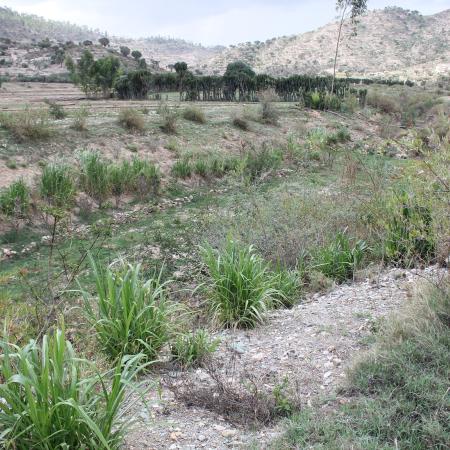
Maego sub-watershed in Kilte Awalalo district, Tigray Region, Ethiopia presents a perfect example of DryDev’s landscape transformation. After DryDev’s actions, smallholders indicated that they are now receiving both environmental, social and economic benefits.
A 10 km long, 35 m wide and 7 m deep gully, created by years of flooding and soil erosion, had divided the village into two parts. Mr Hagos, priest at the local church, recalls “We were unable to exchange goods or even attend funerals and other social events; one had to walk a long distance of 5-6 km to reach the other side of the gully. Two people lost their lives, drowning while attempting to cross during floods.” Children had to walk a long distance to school and women walked three hours daily to fetch water. Villagers from the two sides were unable to support each other in a responsive way when needed. Being very poor, the community thought that gully healing was beyond their powers.
However, with the arrival of the DryDev, their hope grew. During the community action planning process, gully healing was identified as a top priority. However, this was not a simple task and a suite of activities needed to be undertaken to sustainably rehabilitate this area. Regardless, the villagers joined hands with DryDev since the situation affected both economic and social aspects of life.
Within three years, the whole catchment was completely transformed. Gabions and mass planting of perennial grasses and trees stabilized the gully; vegetative cover from application of farmer managed natural regeneration (FMNR) and structures like check dams and trenches improved water infiltration. As a result, the gully has been rehabilitated and the depth now is just 1.5 m. People can cross and meet daily. Women do not have to walk for hours to fetch water: the water table has risen and water is available year-round. Children walk less to school and there is a much higher interaction among people on both sides of the gully. They sell and buy vegetables and fruits from each other. The priest smilingly said: ‘We can now even borrow fire from those living on the other side’.
